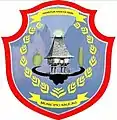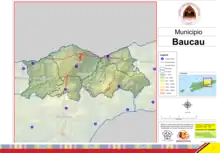Baucau | |
|---|---|
| |
.jpg.webp) Osolata beach | |
.png.webp) Flag  Coat of arms | |
 | |
OpenStreetMap | |
| Coordinates: 8°35′S 126°30′E / 8.583°S 126.500°E | |
| Country | |
| Capital | Baucau |
| Administrative Posts | |
| Area | |
| • Total | 1,504.2 km2 (580.8 sq mi) |
| • Rank | 4th |
| Population (2015 census) | |
| • Total | 123,203 |
| • Rank | 3rd |
| • Density | 82/km2 (210/sq mi) |
| • Rank | 5th |
| Households (2015 census) | |
| • Total | 22,976 |
| • Rank | 3rd |
| Time zone | UTC+09:00 (TLT) |
| ISO 3166 code | TL-BA |
| HDI (2017) | 0.602[1] medium · 9th |
| Website | Baucau Municipality |
Baucau (Portuguese: Município Baucau, Tetum: Munisípiu Baukau) is a municipality, and was formerly a district, of East Timor,[2] on the northern coast in the eastern part of the country. The capital is also called Baucau (formerly Vila Salazar). The population of the municipality is 111,694 (census 2010) and it has an area of 1,506 km².
Etymology
The word Baucau is derived from the word "Akau", which means "pig" in the local Waimoa language. During the Portuguese colonial era, the name of the district was transformed, first into Macau and finally into Baucau. An alternative name for the Baucau community is Wailia-Wailewa, meaning the "great water spring of Wai Lia".[3] In the Wai Lia area (part of the suco of Bahu), a large spring is located under large trees;[3] it is both an animist and a Christian holy place.[4]
In 1936, the Portuguese colonial authorities renamed what was then the district of Baucau as "São Domingos".[5] However, that name, like other imperial-sounding names adopted in the colony at about that time, did not catch on, and a few years after World War II it was quietly abandoned.[6]
Geography

The borders of the District of Baucau during the colonial era were the same as they are now. The north edge of the municipality is to the Wetar Strait; it also borders the municipalities of Lautém to the east, Viqueque to the south, and Manatuto to the west.
Baucau also has a wide coastline with sandy beaches, ideal for swimming and other watersports.
In the administrative post of Venilale are tunnels that the Japanese built during their occupation during the Second World War. Also in this administrative post is an ongoing project to reconstruct and renovate the Escola do Reino de Venilale (School of the Kingdom of Venilale).[7]
Administrative posts
The municipality's administrative posts (formerly sub-districts) are:[8]
Demographics
Besides the national official languages of Tetum and Portuguese, most of the inhabitants speak the Papuan language Makasae. While most of the inhabitants are Roman Catholics, a few Muslims also live there.
Economy
Baucau has the most highly developed agriculture in East Timor. Besides the staples rice and corn, Baucau produces beans, peanuts, sweet potatoes, copra, candlenut and manioc. It also raises buffalo and goats. A shortage of transportation links and the unpredictability of energy availability stymie the development of emerging industries.
Infrastructure
Baucau has the country's longest airport runway, in Cakung Airport,[9] as currently, Dili's Nicolau Lobato International Airport can only serve small airliners like the Boeing 737. The airport is located six km from the city of Baucau. It served as the country's principal airport before the Indonesian invasion in 1975, when it was taken over by the Indonesian military. Bucoli, a village with symbolic role in the East Timorese resistance movement, is located in the subdistrict of Baucau.
Notable people
References
Notes
- ↑ "Sub-national HDI - Area Database - Global Data Lab". hdi.globaldatalab.org. Retrieved 13 September 2018.
- ↑ James Norman (11 February 2017). "Environmental concerns for Timor-Leste cement project". The Saturday Paper. Retrieved 22 February 2017.
- 1 2 "Perfil: 2. Toponímia" [Profile: 2. Toponymy]. Baucau Municipality (in Tetum). Retrieved 18 July 2022.
- ↑ McWilliam, A.; Palmer, L.; Shepherd, C. (2014). "Lulik encounters and cultural frictions in East Timor: Past and present". The Australian Journal of Anthropology. 25 (3): 304–320, at 315. doi:10.1111/taja.12101. Retrieved 25 April 2022.
- ↑ "Diploma Legislativo N°85". Boletim Oficial. Govêrno Colonial. XXXVII Ano (Numero 21). 27 May 1936.
- ↑ Hull, Geoffrey (June 2006). "The placenames of East Timor" (PDF). Placenames Australia: Newsletter of the Australian National Placenames Survey: 6–7. Archived (PDF) from the original on 13 July 2018. Retrieved 25 April 2022.
- ↑ "Escola do Reino de Venilale". GERTiL. 2004. Archived from the original on 3 May 2006. Retrieved 22 February 2017.
- ↑ Gunn, Geoffrey C (2011). Historical Dictionary of East Timor. Lanham, Maryland: Scarecrow Press. p. 49. ISBN 9780810867543.
- ↑ Joanna Podgórska (10 April 2010). "Trzy katastrofy - trzy zamachy? Nr 3: Smoleńsk Siewiernyj, 10.04.2010". na:Temat. Retrieved 22 February 2017.
Bibliography
- Guterres, Modesta Soares; Lopes, Silvino; Mendes, Helder Henriques; Pinheiro, Mateus, eds. (2019). Baucau Em Números 2019 [Baucau in Numbers 2019] (PDF) (in Portuguese) (7th ed.). Baucau: Direcção Geral de Estatística / Estatística Município de Baucau. OCLC 1319823828.
- Soares, Rosália E M (2016). Tais Husi Baucau, Timor-Leste / Os Têxteis de Baucau, Timor-Leste / The Textiles of Baucau, Timor-Leste (in Tetum, Portuguese, and English). Dili: Governo de Timor-Leste. Retrieved 4 May 2023.
- Baucau District Profile (PDF) (Report). April 2002. Archived from the original (PDF) on 28 March 2009. Retrieved 27 February 2022.
- Munisipio Baucau: Planu Estartejiku Desenvolvimentu Munisipal [Baucau Municipality: Municipal Strategic Development Plan] (Report) (in Tetum). Ministry of State Administration (East Timor) / Administration of Baucau Municipality. 2015. Retrieved 17 July 2022.
- Perfil Distritu Baucau [Baucau District Profile] (PDF) (Report) (in Tetum). 2012. Archived (PDF) from the original on 3 March 2014. Retrieved 17 July 2022.
External links
![]() Media related to Baucau (Municipality) at Wikimedia Commons
Media related to Baucau (Municipality) at Wikimedia Commons
- Baucau Municipality – official site (in Tetum with some content in English)
- Baucau Municipality – information page on Ministry of State Administration site (in Portuguese and Tetum)